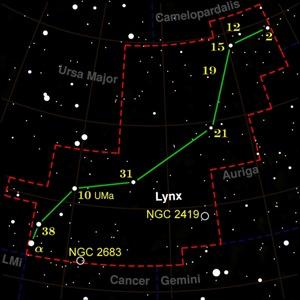
1 minute read
Winter Constellation, Horologium
Spring Constellation –Lynx
Official name of constellation: Lynx, sive Tigris Common Name: Lynx Translation of Name: No translation Myth or Story associated: The Lynx constellation does not have a myth associated with it. However, there is speculation that Johannes Hevelius named the constellation after Lynceus. Lynceus was a sailor who sailed with Jason and the Argonauts and was said to have extremely keen eyesight. History of Discovery: Lynx was introduced by the Polish astronomer Johannes Hevelius. He created the constellation to fill a large gap between the two constellations Auriga and Ursa Major. He named the constellation “Lynx” because it was pretty faint, and it took the eyesight of a lynx to see it. How to Locate in the Night Sky: It is located in the Northern hemisphere and can be seen at latitudes +90° and -55°. It neighbors the constellations Auriga, Camelopardalis, Cancer, Gemini, Leo, Leo Minor, and Ursa Major. It is most visible in the month of February Special Stars or Galaxies: As of 2016, Lynx has six stars with one known planet each. Lynx does not have any Messier objects. The brightest star in the constellation is Alpha Lyncis. Alpha Lyncis has a magnitude of 3.13.
Advertisement













